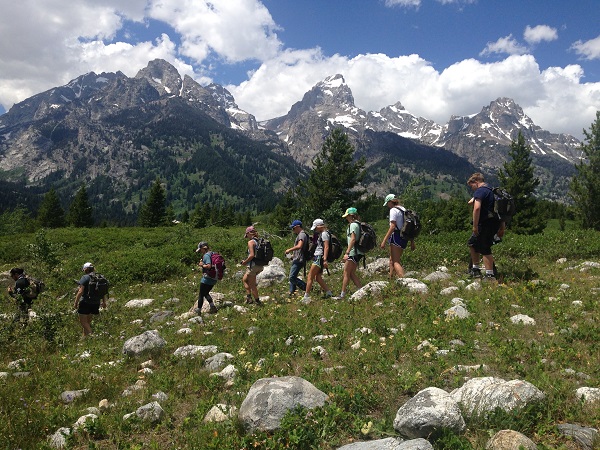“This is going to sound lofty . . . but it has become apparent to me that we – as a society, a world, a country – need connection to place now more than ever . . . . Having public lands, green spaces, [and] public parks for people to experience, recreate, and learn in makes us better people.” ~ Grand Teton National Park Chief of Interpretation and Partnerships, Vickie Mates, answering the question, “What is the point of working together [with TSS] like we do?”
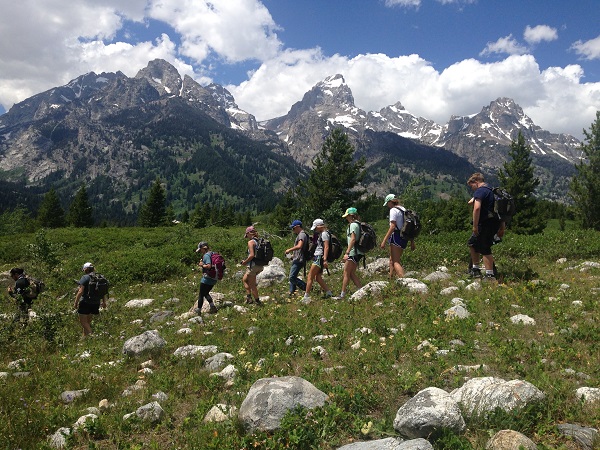
Close your eyes and think of home. What do you see? Friends and family? Neighbors waving as they ride their bikes? The drifting aromas of Italian food and börek on a city street? That perfect spot under the old willow tree that has just enough light to read a book, but shades you enough to mellow a hot summer day?
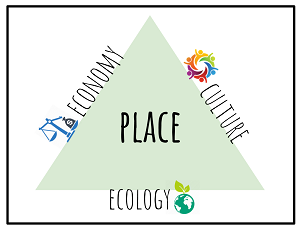 Each of these places share a set of characteristics that Teton Science Schools staff know as the “place triangle:” the intersection and interdependency of the economy, ecology, and culture of a given area. The neighborhood includes more than the people; it’s also the plants, birds, and microorganisms that coexist there (ecology). Your local mediterranean restaurant that serves your favorite börek is more than just a shop; it’s also a beacon of Turkey and Turkish-Americans (culture). And your shady willow tree? That tree’s roots might singlehandedly keep your local roto-rooter business afloat as they clear your pipes twice per year (economy).
Each of these places share a set of characteristics that Teton Science Schools staff know as the “place triangle:” the intersection and interdependency of the economy, ecology, and culture of a given area. The neighborhood includes more than the people; it’s also the plants, birds, and microorganisms that coexist there (ecology). Your local mediterranean restaurant that serves your favorite börek is more than just a shop; it’s also a beacon of Turkey and Turkish-Americans (culture). And your shady willow tree? That tree’s roots might singlehandedly keep your local roto-rooter business afloat as they clear your pipes twice per year (economy).
This dynamic is why I chose to contact two organizations that partner with Teton Science Schools, and to explore this idea of place with them. TSS collaborates with dozens of partners each year in a huge variety of ways – some of them visit our challenge course, some offer stewardship experiences to our participants, some offer their technical or operational support, and some are equal partners in developing and running transformational programs. Yet those descriptions don’t do justice to the cumulative, multiplying power of connections that these relationships represent.
Grand Teton National Park
When I asked Vickie Mates, Chief of Interpretation and Partnerships at Grand Teton National Park (GTNP), what her definition of “place” is, she had clearly considered this question already.
“It’s the sum of all the characteristics of a location that give that location its personality,” she said, continuing, “It’s the ecological communities, [and] it also includes people, culture (both present and past), and how that culture has evolved over time. It’s the spirit of the community.”
GTNP is deeply integrated into the place we know as Jackson Hole. There are economic relationships with concessioners and businesses, cultural connections with the multi-generational families who have established themselves here, and stewardship and recreational relationships with the local community (not to mention the country and world). “Grand Teton feels a part of, rather than apart from, the Jackson community,” Mates said. Indeed, it’s impossible to separate Grand Teton National Park from Jackson Hole.
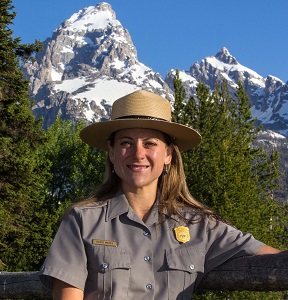 I couldn’t agree more, especially given that TSS and GTNP have been partners since the very beginning. It’s no coincidence that Mates’ answer to the definition of place links tightly to our own. Do you see economy, ecology, and culture represented in her response?
I couldn’t agree more, especially given that TSS and GTNP have been partners since the very beginning. It’s no coincidence that Mates’ answer to the definition of place links tightly to our own. Do you see economy, ecology, and culture represented in her response?
Mates again: “We have been able to sustain a close relationship [with TSS] and build a deep level of trust over 50 years. Not many partnerships can say that, [and] it just keeps getting better.”
In addition to being partners since our inception in 1967, in the past 10 years or so TSS and GTNP have developed and collaborated on powerful, community-altering programs such as NPS Academy, Pura Vida, and Mountains to Mainstreet. We’ve also worked closely with the Park at Kelly Warm Springs each fall, teaching Teton County fifth graders about invasive species, and have brought hundreds (possibly thousands) of volunteers from TSS programs to contribute to Park projects. That’s a legacy that lasts.
I’ve known Vickie for four years now, and in that time we haven’t had the chance to explore our mutual understanding of place together. After our eye-opening conversation, one of her last comments stuck with me. I believe it demonstrates the value of our shared membership in this community:
“If people can understand their own place, they will have more awareness, they can define it, and they will protect it. Protecting these spaces and experiences is important to our identity.”
Identity, spirit, and personality: these are ways of looking at our place together.
Rendezvous Park
Ellie Stratton-Brook is an open book, an eager listener, and a force for positivity. As the Rendezvous Park Community Outreach Coordinator, she represents one of Teton Science Schools’ more recent partnerships, and it’s one that has significantly impacted our daily programming.
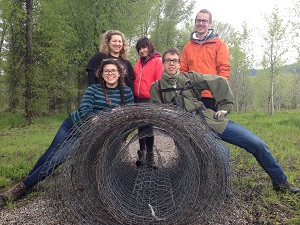 The park itself (known casually as R-Park) was basically a gravel yard just a few years ago, and is now the county’s only public, non-profit run park. As Stratton-Brook said, “We are the product of our community’s expressed need.” One particular need that R-Park filled was a nearby location for evening programs for TSS participants; most weeks, one can find small field groups of young learners exploring, learning, and connecting in some corner of the park.
The park itself (known casually as R-Park) was basically a gravel yard just a few years ago, and is now the county’s only public, non-profit run park. As Stratton-Brook said, “We are the product of our community’s expressed need.” One particular need that R-Park filled was a nearby location for evening programs for TSS participants; most weeks, one can find small field groups of young learners exploring, learning, and connecting in some corner of the park.
Just as Mates did, Stratton-Brook dove headlong into my question about the definition of place.
“Place is a point in space,” she began, “but you define it with how you use it, and how you label it… Anywhere can be a place; it becomes individual when you think about how it’s used, and [by whom].”
Once again it became clear through our conversation that R-Park is another excellent example of the intersection between economy, ecology, and culture. Its former role was purely economic in nature (industrial), but even in its current state it represents community funding (economy). It’s also a hangout area for moose, herons, and a huge variety of riparian wildlife (ecology), and it acts as a gathering point for stargazing, floating, bird-watching, and so much more (culture).
 For all of these reasons, TSS and R-Park form a natural connection in the Jackson community. TSS brings participants and volunteers both locally and from around the country, while R-Park provides an intentional space to share, reflect, and learn. “We aid in each others’ efforts to provide for and educate the public,” Stratton-Brook said, sharing my own sentiment.
For all of these reasons, TSS and R-Park form a natural connection in the Jackson community. TSS brings participants and volunteers both locally and from around the country, while R-Park provides an intentional space to share, reflect, and learn. “We aid in each others’ efforts to provide for and educate the public,” Stratton-Brook said, sharing my own sentiment.
While the Teton Science School – Rendezvous Park relationship is a relatively new one, we are well primed to maintain that relationship and build trust for years to come. As Stratton-Brook remarked during the close to our interview, “We plan on being around forever. In order to do that, we have to steward the land, respect change, and evolve. We need to be connected to our partners – otherwise we wouldn’t exist.”
Our greatest challenge, and our future
All places – the neighborhood, the börek shop, the backyard – are more than the sum of their parts; they are manifestations of complex interrelationships, and they all face their particular challenges. When I asked Mates and Stratton-Brook about our greatest challenge as a community of partners, an unsurprising link appeared.
Stratton-Brook: “Even though there are already 250 nonprofits [in Jackson], it’s apparent that there are still community needs, and the infrastructure doesn’t always support them. It’s our responsibility to prioritize and decide on what’s the most important and urgent need, and to focus on that.”
Mates: “How do you pick what to work on together? There is so much creativity, and so many ideas for how to advance our work. How do you pick the areas of highest impact and really focus on them?”
 This place we know as Jackson Hole, with its flaws and foibles, epic vistas and wild places, and complex people with changing needs, is a wonderful place in large part because of the connections the people and organizations have made here. It is comforting to know that everyone – Teton Science Schools, Grand Teton National Park, Rendezvous Park, and so many more – is working to identify our ongoing needs and then actively respond to them. I’m deeply grateful to these partners and all others for offering up their skin alongside us.
This place we know as Jackson Hole, with its flaws and foibles, epic vistas and wild places, and complex people with changing needs, is a wonderful place in large part because of the connections the people and organizations have made here. It is comforting to know that everyone – Teton Science Schools, Grand Teton National Park, Rendezvous Park, and so many more – is working to identify our ongoing needs and then actively respond to them. I’m deeply grateful to these partners and all others for offering up their skin alongside us.
If I could condense my conversations with these two incredible leaders into a single statement, my message would be that years and decades of integration and collaboration have not dulled our drive or motivations. We never become complacent, or stop seeking to define, shape, and steward our place with innovation, opportunity seeking, and classic good humor. I hope that when you look at your place, wherever it may be, you feel the same.

